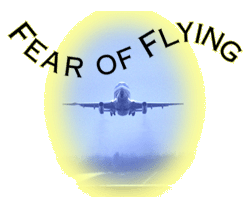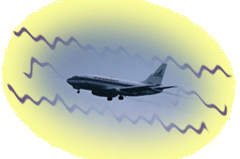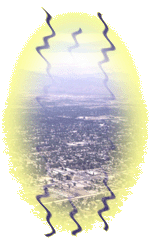
Every time a plane crashes about 25 percent of Americans get fuel for their phobia. People are afraid of flying for all kinds of reasons -- claustrophobia, lack of control, or just the fear of dropping out of the sky. But there are ways to counter these phobias -- acupuncture, hypnotherapy, group support ... and the latest addition is a virtual reality computer program. It's software that allows you to see, hear and feel a plane flight without getting anywhere near one. Reporter Marianne McCune visited one of five places in the country that uses Virtually Better's new program.
Fear of Flying
by Marianne McCune
Anna Michalec has flown three hair-raising times in her 68 years. That was
enough.

Michalec: "The last time I flew it was about 12 years ago. And as soon as I just came to the airport -- my friend dropped me off -- that was anxiety. I just couldn't get out of it."
This, from the movie Fearless, is what she imagined: [Sound of crash]
Michalec: "Then I started to take the Greyhound bus." [Laughs]
Kahan: "We all have the ability to get frightened and that's really necessary for survival."
Fear stops us from walking off the edge of a cliff and that's good, says
Dr. Michael Kahan, physician in charge of the phobia clinic at Hillside
Hospital in Long Island, New York. But sometimes that functional system
goes awry, like a car alarm so touchy it blares every time a heavy truck
rolls by.
Kahan: "People need to basically recognize that in some instances their fear is a false alarm."
If you aren't afraid of getting in a car, there's no rational reason to
fear boarding a plane -- the chances of death or injury in a plane crash are
miniscule by comparison. The trick, for those afraid, is to train your mind
not to set off the alarm, and one way that's done is by exposure therapy.
That's what Virtually Better is all about. Anna Michalek saw it advertised
just before she retired.
Michalec: "I said 'Hey, let me try that.' Perhaps I could go back to the Slovak Republic. So that's really you know the reason, cause I really want
to go back and see the village I was born in. I wonder if the stream is
there that I think I remember."
To propel herself across the Atlantic Ocean and Western Europe, Michalec
sat down in a small office in Long Island. She strapped herself into a grey
vinyl seat and donned a virtual reality headset.
Kahan: "There's a visual experience inside the headsets so the external
environment is really blocked out."
Michalec: "I look in front and there are chairs, just like you're sitting in an airplane."
Kahan: "There's an auditory experience in the headphones, so it's different
even then sound surround in a movie theatre."
The flight attendants are barely audible -- this must be an older plane.
Michalec: "And then you're ascending and you see the sky. And over here you
see another window when you look this way."
Kahan: "You can look out the window and see other planes or you can see
buildings receding. And the seat vibrates."

Though you can't see Dr. Kahan, he sits directly across from you with his
own computer screen showing him exactly what you're seeing. He'll watch to
see when you grip the edges of your seat or when your breath and heart pick
up speed. And he'll ask you how your feeling.
Michalec: "The therapist tells you now we're headed for a storm. And you see all the dark clouds. Palpitations, you're sweating a little. Shaking a little. 'Oh God, let me get through this.' And just let me get off as soon
as possible, I just can't stand it anymore."
Kahan: "I've been somewhat surprised at how powerful it really is, that
people's anxiety really does get evoked."
Kahan says sometimes some long-forgotten memory is triggered by a virtual
flight and the patient is able to work through it.
Kahan: "The key to behavior therapy is doing a prolonged or repeated exposure
to give the opportunity for the anxiety to subside. So there becomes a
disconnect between that situation and the person's fear."
Michalec: "Now please take your seats, tighten your seatbelts, we're heading
for a landing. We head for a landing and you hear the wheels go, dooh dooh,
and we land."
[Plane lands]
Michalec: "I feel perfectly calm."
Michalec is now a pro at virtual flying. She's even been visiting JFK
airport to watch the planes come and go. When she begins to tense up, she
talks herself out of it. Or she puts her hand on her solar plexis to
breath.
So now she has the tools -- all she needs is the ticket. Experts say the
key to getting back into flight is motivation -- you've got to want to go
some place. That's what will ultimately bring Michalec back to her
birthplace.
Michalec: "It's just a little stream going through -- I don't know. I guess
there was a lot of farm land, too. And there were horses, I even think I
imagine the horses sometimes. Chickens, of course. Yeah."
Doctors recommend a shorter flight first, so Michalek is planning a trip
to Florida, where she flew 12 years ago. Then she'll head to the farm.
From Long Island, this is Marianne McCune for the Savvy Traveler
Savvy Resources on the Fear of Flying:
- "Fly Without Fear"
Provides information packets (for $5.00) and runs support groups for people with fear of flying.
Contact: Carol Cott Gross
Phone: 212-697-7666
Address: 211 E. 43rd, New York, NY 10017
- Virtually Better Inc.
Atlanta-based and has a Web site: www.virtuallybetter.com. They list the sites that administer the program.
|
|






